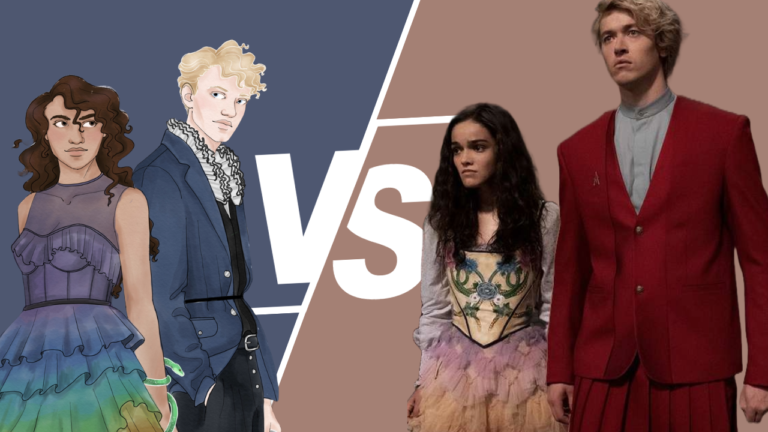Through the Sands: A Spicy Comparison of the Dune Books and Movies

Few works in the vast expanse of science fiction literature hold the revered status of Frank Herbert’s Dune saga. Published in 1965, the six-book saga is widely regarded as one of the greatest works of science fiction, inspiring countless adaptations and homages.
The novels are set in a distant future where noble houses vie for control over the desert planet of Arrakis, the only source of a valuable spice called melange. The story follows the young nobleman Paul Atreides, whose family is entrusted with the stewardship of Arrakis. We see Paul and his family navigate the treacherous politics of Arrakis and become embroiled in a power struggle with rival houses, including the sinister House Harkonnen.
As Paul adapts to life on Arrakis, he uncovers secrets about his own identity and discovers his unique connection to the planet and its indigenous people, the Fremen. With the help of the Fremen, Paul embarks on a journey of self-discovery and revolution, ultimately leading to his transformation into a messianic figure known as Muad’Dib.
Along the way, Paul faces numerous challenges, including political intrigue, betrayal, and personal conflicts, as he grapples with his true nature. But when he chooses to embrace his destiny, Paul becomes a symbol of hope for the oppressed people of Arrakis and sparks a rebellion against the oppressive rule of the Empire.
Now, with the recent release of the cinematic duology, including the Academy Award-winning Dune: Part One in 2021 and now the eagerly anticipated Dune: Part Two in March 2024 (and hopefully a trilogy soon) directed by the visionary Denis Villeneuve, fans have been given another opportunity to traverse the sands of Arrakis and beyond.
However, as with any adaptation, the question looms: how do these cinematic incarnations stack up against the source material?
Faithful with a Twist
One of the most commendable aspects of Villeneuve’s adaptations is his unwavering commitment to remaining faithful to Frank Herbert’s vision of the world he created.
From the expansive desert vistas to its intricate political machinations, the films strive to capture the essence of Herbert’s narrative. Villeneuve’s meticulous attention to detail ensures that key elements of the books are brought to life on the big screen, allowing fans to lose themselves once more in the desert of Arrakis amid the intrigue, drama, and tensions that follow our young protagonist.
The sweeping vistas of Arrakis, the intricate politics of the Imperium, and the internal conflicts of its characters are all meticulously crafted to honor the source material. From the ornate stillsuits of the Fremen to the towering majesty of the sandworms, the films pay homage to Herbert’s vivid imagination, inviting viewers to immerse themselves in the world of Dune.
Yet, more complicated than maneuvering non-rhythmically through the sandy wasteland to avoid the majestic Sandworms, remaining faithful to the source material is a delicate dance.
While Villeneuve succeeds admirably in many aspects, some deviations are inevitable for the sake of brevity. As fans eagerly await the next chapter, they can take solace in the fact that their favorite characters, scenes, and moments may yet have their moment to shine in the desert sun.
Notable Character Changes
In the journey from page to screen, characters often transform tremendously, even going so far as merging into entirely new characters. While these films successfully translate the essence of the characters, some find themselves with less screen time than their literary counterparts.
For example, Dr. Yueh’s betrayal lacks the depth and complexity present in the novel, while characters like Thufir Hawat and Beast Rabban Harkonnen receive less airtime than their novel counterparts.
One of the significant alterations in the cinematic adaptation is the portrayal of Alia, Paul Atreides’ sister and a pivotal character in the Dune saga.
In the novels, Alia is a preborn, inheriting the memories and consciousness of her ancestors, leading to a complex and multifaceted personality embodied in an infant. However, the films take a different approach to Alia’s character. In the cinematic adaptation, Alia’s role is notably altered. Instead of being portrayed as a fully developed character at 3 years old, Alia is depicted as a voice or presence within the womb of her mother, Jessica.
This departure from the source material simplifies Alia’s character, focusing solely on her potential future significance rather than exploring her complex internal struggles and development. While this change may streamline the narrative for cinematic purposes, it diminishes Alia’s depth and complexity as a character, reducing her to a more symbolic role rather than a fully realized individual. Although, she does escape becoming the next CGI baby meme.
In the novels, Thufir Hawat serves as the loyal mentat advisor to House Atreides, playing a crucial role in the intricate political machinations of the story. His absence in the films deprives audiences of a key character who embodies loyalty, intelligence, and morality.
Thufir’s presence adds layers to the Atreides-Harkonnen rivalry and provides insight into the complexities of power struggles within the Imperium. Additionally, Count Fenring is a mysterious and enigmatic figure in Herbert’s novels with a unique relationship with the Atreides and the broader political landscape. His absence in the films eliminates an intriguing character who could have added depth to the narrative and offered alternative perspectives on the unfolding events. Fenring’s inclusion would have enriched the portrayal of power dynamics and alliances within the Imperium.
One of the most significant character changes occurs with Liet Kynes.
In the novels, Kynes is depicted as a male character deeply entrenched in the ecological and political intricacies of Arrakis. However, Villeneuve’s adaptation opts for a gender swap, introducing a refreshing modernization of the characters without sacrificing their essence. This change not only diversifies the cast but also adds new layers to Kynes’ portrayal, showcasing the character’s adaptability across different iterations.
Not The Hero We Think
In both Frank Herbert’s Dune novels and the cinematic adaptations, the character of Paul Atreides occupies a complex space between traditional heroism and moral ambiguity. While audiences often perceive him as a hero destined to save the universe, the books, and the films challenge this conventional narrative, presenting Paul as a figure driven by his desires and thirst for power rather than pure altruism.
Herbert’s novels depict Paul’s journey as far from a traditional hero’s quest.
While he gains immense power and influence, his actions are often driven by personal motivations, including a desire for revenge and the preservation of his own dynasty. As the narrative progresses, Paul grapples with the consequences of his choices and the moral complexities of leadership, blurring the lines between heroism and self-interest.
Denis Villeneuve’s cinematic adaptations honor Herbert’s portrayal of Paul as a morally ambiguous protagonist. Rather than presenting him as a straightforward hero, the films delve into Paul’s internal struggles and the darker aspects of his character. This nuanced interpretation adds depth to Paul’s arc, challenging audience expectations and subverting the traditional hero’s journey trope.
Central to Herbert’s vision in the Dune series is the idea that no single individual, no matter how powerful or influential, can be viewed as a pure hero. Instead, characters like Paul Atreides embody the moral complexities and contradictions inherent in human nature, challenging simplistic notions of heroism and villainy.
Villeneuve’s adaptations remain faithful to Herbert’s vision, presenting Paul as a flawed and morally ambiguous figure rather than a traditional hero.
By embracing the antiheroic elements of Herbert’s narrative, the films offer a nuanced portrayal of Paul’s character, highlighting the moral dilemmas he faces and the consequences of his actions.
What’s Missing and Does it Matter?
While Villeneuve’s dedication to faithfulness is commendable, certain key scenes from the books are altered or omitted in the films.
The absence of the iconic dinner party sequence (no spoilers for future readers) may leave fans hungering for more. At the same time, Paul’s first encounter with Chani and his subsequent duel with Jamis may differ from the book, albeit in ways that only serve to enhance cinematic tension without compromising the narrative.
The ritualistic consumption of the Water of Life by Paul and Jessica is a pivotal moment in Herbert’s saga, symbolizing initiation, transformation, and spiritual awakening. The Water of Life ceremony is a cornerstone of Fremen culture and spirituality, and its proper inclusion would have deepened the cinematic portrayal of their society.
However, where one scene fades, another may bloom.
Villeneuve’s direction brings Herbert’s vivid descriptions to life, immersing viewers in the harsh landscapes of Arrakis and the opulent interiors of the Imperium. Every aspect of the production design contributes to a sense of epic scale and grandeur, reminding fans why they fell in love with Dune in the first place.
Villeneuve’s direction brings Herbert’s vivid descriptions to life, immersing viewers in the harsh landscapes of Arrakis and the opulent interiors of the Imperium. Every aspect of the production design contributes to a sense of epic scale and grandeur, reminding fans why they fell in love with Dune in the first place.
Shortened Timelines
The timelines in Frank Herbert’s Dune novels and Denis Villeneuve’s cinematic adaptations differ subtly but significantly. Herbert’s novels employ a rich tapestry of interwoven timelines, spanning generations and civilizations, allowing for deep exploration of character development and political intrigue.
In contrast, Villeneuve’s adaptations condense and streamline the timeline to fit the constraints of the film, sacrificing some intricacies for tighter pacing and narrative focus.
An example of this can be seen in the depiction of Paul Atreides’ journey from reluctant hero to messianic figure. While Herbert dedicates extensive time to Paul’s gradual transformation across multiple novels, Villeneuve compresses this arc into a shorter narrative timeline, focusing on key moments of revelation and self-discovery.
Another is Alia’s birth, as she remains in Jessica’s womb instead of aging up 3 years, signifying once again that the events of the films take place over a much shorter period than the novels. These practical choices in no way deter from the immense awe of the story or sway from the message of Dune.
All Paths Lead to Dune
As we bid farewell to the cinematic journey through the sands of Arrakis (for now), one thing is clear – while the Dune films offer a visually stunning and faithful adaptation of Frank Herbert’s beloved novels, they inevitably diverge in certain aspects due to the constraints of the medium. Yet, amidst the shifting sands of adaptation, one truth remains constant: Dune endures.
As fans eagerly await the next installment, it’s clear that Villeneuve’s vision has reignited interest in this timeless tale.
Whether you’re a die-hard fan of the books or a newcomer to Herbert’s universe, there’s no denying the enduring appeal of Dune. So, as we eagerly await the release of Part Three (fingers crossed), let us raise a toast to Denis Villeneuve and his cinematic odyssey through the sands of Arrakis.
Long live Dune!


